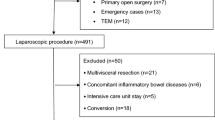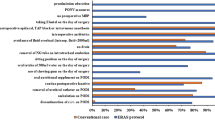Abstract
Background
Perioperative fluid restriction can lead to better clinical outcomes and reduced complications. However, whether perioperative fluid restriction can alter the patient’s postoperative cellular immunity is unknown. Therefore, a randomized, prospective clinical study was designed to determine whether fluid restriction improves immunological outcome in elderly patients who undergo gastrointestinal surgery for cancer removal.
Methods
A total of 179 patients aged 65 years or older were recruited for the study and were randomly assigned to receive the restricted fluid regimen (R group) or the standard fluid regimen (S group). Postoperative T-lymphocyte subpopulations (CD3+, CD4+, and CD8+) frequencies and monocyte HLA-DR expression was investigated. Perioperative complications and cellular immunity changes were analyzed comparatively between the two groups.
Results
The restricted intravenous fluid regimen was associated with significantly less postoperative complications (1.5 complications/patient vs. S group: 2.2 complications/patient), especially for infection complications (15% vs. S group: 27%, p = 0.04). Circulating CD3+ T-cells were suppressed after surgery in both treatment groups, but the cell frequency (cell/μL) was higher in the R group (746 vs. S group: 480 at postoperative day (POD) 2, p = 0.022; 878 vs. 502 at POD 3, p = 0.005; 892 vs. 674 at POD 5, p = 0.042). Similarly, the HLA-DR expression (% of all T cells) in monocytes were decreased in both groups, but the expression remained higher in the R group (66.20 vs. S group: 51.97 at POD 1, p = 0.029; 68.19 vs. 51.26 at POD 2, p = 0.039; 72.19 vs. 57.45 at POD 3, p = 0.014; 73.92 vs. 60.46 at POD 5, p = 0.036). Multivariate analysis suggested that perioperative CD3+ T cell changes were associated with the development of postoperative complications [odds ratio (OR) = 1.963; 95% confidence interval (CI) 1.019–3.782; p = 0.044] and postoperative infections (OR = 3.106; 95% CI 1.302–7.406; p = 0.011).
Conclusions
In elderly gastrointestinal cancer patients, cellular immunity is better preserved by the perioperative fluid restriction regimen. The better preserved cellular immunological function is correlated with a reduced perioperative complications rate.





Similar content being viewed by others
References
Wise WE, Padmanabhan A, Meesig DM et al (1991) Abdominal colon and rectal operations in the elderly. Dis Colon Rectum 34:935–963
Lobo DN, Bostock KA, Neal KR et al (2002) Effect of salt and water balance on recovery of gastrointestinal function after elective colonic resection: a randomized controlled trial. Lancet 359:1812–1818
Girish PJ (2005) Intraoperative fluid restriction improves outcome after major elective gastrointestinal surgery. Anesth Analg 101:601–605
Stewart R, Tjun Y, Eamonn C et al (2008) Perioperative fluid restriction reduces complications after major gastrointestinal surgery. Surgery 143:46–48
Wenkui Y, Ning L, Jianfeng G et al (2010) Restricted peri-operative fluid administration adjusted by serum lactate level improved outcome after major elective surgery for gastrointestinal malignancy. Surgery 147(4):542–552
Lang K, Suttner S, Boldt J et al (2003) Volume replacement with HES 130/0.4 may reduce the inflammatory response in patients undergoing major abdominal surgery. Can J Anesth 50(10):1009–1016
Gombocz K, Beledi A, Alotti N et al (2007) Influence of dextran-70 on systemic inflammatory response and myocardial ischaemia-reperfusion following cardiac operations. Crit Care 11(4):87–97
Boldt J, Suttner S, Brosch C et al (2009) The influence of a balanced volume replacement concept on inflammation, endothelial activation, and kidney integrity in elderly cardiac surgery patients. Intensive Care Med 35:462–470
Engel J, Wlters I, Rupp M et al (2001) Influence of colloid fluids on polymorphonuclear granulocyte function in vivo. Acta Anaesthesiol Scand 45:385–389
Brandstrup B, Tonnesen H, Beier-Holgersen R et al (2003) Effects of intravenous fluid restriction on postoperative complications: comparison of two perioperative fluid regimens. A randomized assessor-blinded multicenter trial. Ann Surg 238:641–648
Hoechtlen-Vollmar W, Menzel G, Bartl R et al (2000) Amplification of cyclin D1 gene in multiple myeloma: clinical and prognostic relevance. Br J Haematol 109:30–38
Duignan JP, Collins PB, Johnson AH et al (1986) The association of impaired neutrophil chemotaxis with postoperative surgical sepsis. Br J Surg 73:238–240
Utoh J, Yamamoto T, Utsunomiya T et al (1988) Effect of surgery on neutrophil functions, superoxide and leukotriene production. Br J Surg 75:682–685
Kawasaki T, Ogata M, Kawasaki C et al (2007) Effects of epidural anaesthesia on surgical stress-induced immunosuppression during upper abdominal surgery. Br J Anaesth 98:196–203
Christou NV, Meakins JL (1982) Phagocytic and bactericidal functions of polymorphonuclear neutrophils from anergic surgical patients. Can J Surg 25:444–448
Sandoval BA, Robinson AV, Sulaiman TT et al (1996) Open versus laparoscopic surgery: a comparison of natural antitumoral cellular immunity in a small animal model. Am Surg 62:625–631
Pantrice F, Valerie C, Patricia L et al (2010) Dose analgesia and condition influence immunity after surgery? Effects of fentanyl, ketamine and clonidine on natural killer activity at different ages. Eur J Anaesthesiol 27:233–240
Cristaldi M, Rovati M, Elli M et al (1997) Lymphocytic subpopulation changes after open and laparoscopic cholecystectomy: a prospective and comparative study on 38 patients. Surg Laparosc Endosc 7:255–261
Eggermont AM, Steller EP, Sugarbaker PH (1987) Laparotomy enhances intraperitoneal tumour growth and abrogates the antitumor effects of interleukin-2 and lymphokine-activated killer cells. Surgery 102:71–78
Vallina VL, Velasco JM (1996) The influence of laparoscopy on lymphocyte subpopulations in the surgical patient. Surg Endosc 10:481–484
Walker WS, Leaver HA, Yap PL (1999) The immune response to surgery: conventional and video assisted thorascopic pulmonary lobectomy. In: Yim APC (ed) Minimal access cardiothoracic surgery. WB Saunders, Philadelphia, pp 127–134
Sansoni P, Cossarizza A, Brianti V et al (1993) Lymphocyte subsets and natural killer cell activity in healthy old people and centenarians. Blood 82:2767–2773
Ogata K, Tamura H, Yokose N et al (1996) CD4 lymphopenia and risk of infection in immunogerontologically healthy elderly people. Lancet 347:1408
Leaver HA, Craig SR, Yap PL et al (2000) Lymphocyte responses following open and minimally invasive thoracic surgery. Eur J Clin Invest 30(3):230–238
Lobo DN, Bostock KA, Neal KR et al (2002) Effect of salt and water balance on recovery of gastrointestinal function after elective colonic resection: a randomized controlled trial. Lancet 359:1812–1818
Turina M, Miller FN, Tucker CF et al (2006) Short-term hyperglycemia in surgical patients and a study of related cellular mechanisms. Ann Surg 243:845–851
Ardeshna KM, Pizzey AR, Devereux S et al (2000) The PI3 kinase, p38 SAP kinase, and NF-κB signal transduction pathways are involved in the survival and maturation of lipopolysaccharide-stimulated human monocyte-derived dendritic cells. Blood 96:1039–1046
Dandona P, Aljada A, Mohanty P et al (2001) Insulin inhibits intranuclear nuclear factor κB and stimulates κB in mononuclear cells in obese subjects: evidence for an anti-inflammatory effect? J Clin Endocrinol Metab 86:3257–3265
Lang F, Busch GL, Ritter M et al (1998) Functional significance of cell volume regulatory mechanisms. Physiol Rev 78:248–273
Yamauchi H, Kobayashi E, Yoshida T et al (1998) Changes in immune endocrine response after surgery. Cytokine 10:549–554
Acknowledgments
This research was supported by Grant 01Z011 from the Key Project of the Tenth-Five-year Plan Foundation of PLA, Grant BK2007573 from the Foundation of Jiangsu Natural Science and Grant 30801086 from the Foundation of China National Natural Science.
Author information
Authors and Affiliations
Corresponding author
Additional information
Trial registration: NCT01399814.
Rights and permissions
About this article
Cite this article
Gao, T., Li, N., Zhang, Jj. et al. Restricted Intravenous Fluid Regimen Reduces the Rate of Postoperative Complications and Alters Immunological Activity of Elderly Patients Operated for Abdominal Cancer: A Randomized Prospective Clinical Trail. World J Surg 36, 993–1002 (2012). https://doi.org/10.1007/s00268-012-1516-1
Published:
Issue Date:
DOI: https://doi.org/10.1007/s00268-012-1516-1




